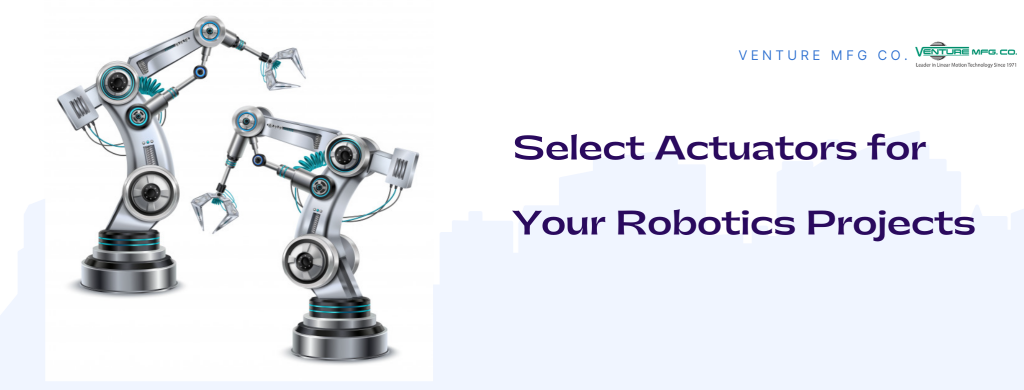Robotics is an extremely intricate field, especially when it comes to building a robot to perform specific tasks. Robots are built to sense the environment and perform the task by manipulating the obstacles. Sensing an environment is more of a sensor’s task but acting on a specific task is performed by actuators. A robot is fitted with different actuators, which perform different activities on receiving a message from a sensor. Being a field that demands precision, it becomes important to select appropriate actuators for your robot. For this selection, there are two stages- first, you must know the available types of actuators and second, you must know consideration factors. This post focuses exactly on these two stages. The types of actuators are discussed followed by the selection guidelines for actuators.

Types of Actuators Suitable for Robotics
Robotics demand precision because they are designed to simulate human movements. Robots generally perform a linear or rotary movement of their active parts. Therefore, the actuators are selected according to the type of motion required. Let us discuss types of actuators for robots according to motion requirements.
- Actuators for Linear Motion Activity: The actuators that generate linear motion are listed as follows.
- Linear Actuators: Linear actuators trigger push or pull activity of the robot. Generally, actions like forward or reverse motion of the robot, successive distance travel, and arm extension are the activities triggered using linear actuators. The active end of this actuator is connected to the lever arm of a robot to trigger such motion.
- Solenoid Actuators: Solenoids are special-purpose linear actuators. These actuators feature a solenoid latch that acts on electromagnetic activity. Solenoid actuators are used for controlled motion. Robot activities like a push button, latch, start and reverse, etc are performed using these solenoid actuators.
- Actuators for Rotational Motion Activity: The actuators that generate rotational motion are listed as follows.
- DC Motor Actuators: These actuators are mostly utilized for rotary robotic motion. DC motor actuators come in varying sizes and torque generation capacity. Therefore, it can be used for varying speed during rotary motions. The activities like robotic drilling, robotic drivetrain motion, are performed by using DC motor actuators.
- Servo Actuators: Servo motor actuators are used for controlled and monitored rotary motion. These are advanced types of DC motors that allow 360° rotation, however, the continuous rotation is not mandatory. It allows halts during a rotational motion. The activities like pick and place are performed by using these actuators.
- Stepper Motor Actuators: Stepper motor actuators contribute to repetitive rotational activities in robots. These actuators are an amalgamation of DC motors and servo motor actuators. For automation robots where repeatability of an activity is required, these stepper motor actuators are used.
After the whole discussion, it is needless to say that type of activity and type of actuators must go hand in hand while selecting actuators for robotics. This certainly becomes of the criteria. However, there are few more factors you need to consider to select actuators for robotics. Let’s discuss the same.
Guidelines to Select Actuators for Robotics
Robots are built for various purposes. Therefore, while selecting actuators for robotics, the following factors need to be considered.
- Purpose of the Robot: The purpose of the robot is the first important consideration while selecting an actuator. For appropriate selection, you must know what activities are to be performed by a robot. For example: If a robot is expected to perform forward and backward motion along with pick and place operation. In this case, a linear actuator for straight-line motion and servo motors for arm articulation can be used.
- Aesthetic Requirements and Constraints: Appearance of the robot is a big consideration in robotic design. If the robot is designed for delicate activities, it must have lightweight actuators. If the robot has speed constraints, then stepper motor with torque limitation is important to use.
- Mounting Space: Mounting space and control linkage are to be considered while selecting actuators. If there is mounting space limitation or requirement of an external controlling lever, then the actuator must meet these conditions.
- Communication/Command Protocol: Robots are operated using virtual control technologies. Mostly, pulse width modulation (PWM) or serial communication protocols are used in the robotic controls. Therefore, the command/communication protocol and type of actuator must go hand in hand.
- Control Interface: There are many control or monitoring interfaces available for robotics. These interfaces function based on PWM or serial communication protocols. These are often digital controls that allow virtual command and control operations in robotics. The actuator must be compatible with these control interface software.
Now that all the selection guidelines are stated, your selection of actuators for robotics applications should be quick and easy. Along with these, ensure that you select actuators for robotics from trusted brands that assure quality, customer support, and unlimited technical support.
